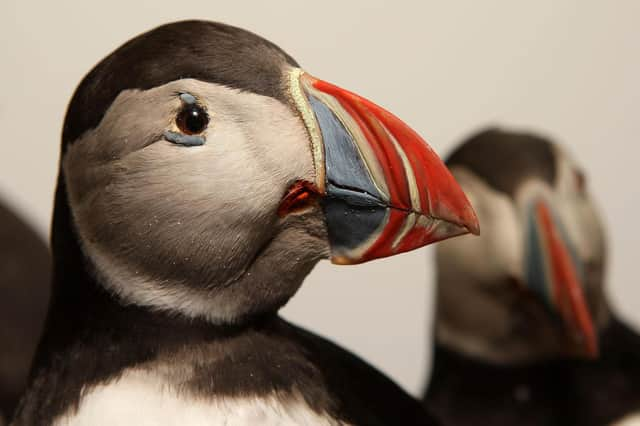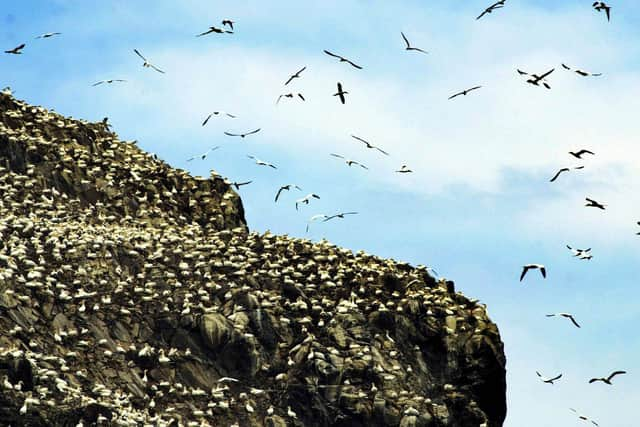Puffins face extinction in Scotland with overfishing of their main source of food, sandeels, to make animal feed a major problem – Philip Lymbery


Nearby, Bill Oddie was opening a new visitor’s centre in the former shore station at Hermaness nature reserve. It was the mid-1990s, and for me a case of right time, right place: I found myself drafted into a photoshoot with ‘birdman’ Bill.
A real bonus, especially as I had long admired the former Goodie for his naturalist exploits as well as his TV comedy. With the trip already unforgettable, I later set off to see seabirds on surrounding cliffs so steep, they gave you a sensation of being at the edge of the world.
Advertisement
Hide AdAdvertisement
Hide AdWhilst the main reason for my visit to Britain’s far north was to see a rare black-browed albatross, one of the most fascinating sights from the trip were puffins that make clifftop burrows their home.
Portly little gentlemen wearing dinner jackets and bright orange shoes is how they look. Their multi-coloured beaks are unmistakeable. I love the way puffins throw themselves off the cliff edge and out to sea. Landing again is not so easy. I wish them luck as they descend, orange legs splaying before they crash-land back into the colony!
Many a time, I’ve seen puffins grasping bunches of small silvery-thin fish in their beaks: sandeels. These little fish are rocket fuel for hungry chicks.
When not breeding, puffins go far out to sea for the winter where they rely on catching small fish to keep them going.


Wrecked
How sad then to hear recently of more than 100 dead puffins having been washed up on Scottish shores in one of the worst ‘puffin wrecks’ in half a century. Their emaciated bodies littered the coasts of north-east Scotland, Orkney and Shetland, suggesting the birds were unable to find enough food whilst out at sea. Those found could well be the tip of the iceberg, with puffin breeding colonies this spring likely to be hit hard.
Finding lots of birds washed up and weakened points to something seriously wrong out there on their wintering grounds where they feed on small fish.
The Scottish government has been investigating the cause of such an “unusual and distressing event”. Severely weakened birds have also been found and taken to local vets for treatment.
Over 100 birds have been tested for avian flu, with all tests coming back negative, meaning the reason for their deaths lies elsewhere.
Advertisement
Hide AdAdvertisement
Hide AdInvestigations are focusing on two possible causes: marine algal blooms and a breakdown in the birds’ food supply chain.
Overfishing
One possibility is that the small fish that puffins need to survive are being overfished – for animal feed. Known in fisheries circles as forage, bait or ‘trash’ fish, species like anchovies, herring, capelin and sandeels are caught in vast numbers.
The logic goes that because they are too small for people to eat directly, we may as well feed them to farmed animals. The trouble with that calculation is this: these small fish are the cornerstone of the marine ecosystem, sustaining seabirds and mammals as well as the bigger fish that we eat. Without them, the marine food web starts to unravel. Creatures further up the ecological chain, like puffins, end up starving.
I remember on Shetland, one of the locals telling me how bad breeding seasons for puffins were often dismissed as being caused by climate change; he thought it strange that those same bad breeding seasons seemed to coincide with the appearance in the area of big fishing trawlers.
It prompted me to do some research. I found that sandeels in the North Sea were being overfished. Between 1994 and 2003, some 880,000 tonnes were sucked out of the water, a scale of catch that proved unsustainable. Subsequent sandeel catches fell by two-thirds.
So why are so many sandeels being scooped out of the ocean in the first place? To produce fishmeal and oil, with much of the fishmeal being used to feed farmed animals.
Much of that fishmeal feeds farmed salmon, which itself has become big business in Scotland. Salmon, the ‘king of fish’, has been reduced to mere commodity status, with tens of thousands crammed into sea pens that wreak havoc on the environment.
Joining the dots
Thankfully, scientists are starting to join the dots; the authoritative Handbook of the Birds of the World cited fisheries that target small pelagic ‘keystone’ fish as the “single most important factor influencing the future welfare of fish-eating auks”, like puffins.
Advertisement
Hide AdAdvertisement
Hide AdEurope’s puffins are now classified as “endangered” on the International Union for Conservation of Nature's ‘Red List’. As well as climate change and extreme weather events, this leading conservation body cites lack of food as a major threat due to “unsustainable harvesting of prey species by commercial fisheries”.
The British Trust for Ornithology (BTO) has recently predicted that puffin numbers could plummet by 90 per cent. The BTO’s Professor Juliet Vickery believes that “there is a very real chance that our grandchildren may never know what it is like to see a puffin in Britain and Ireland”.
Whatever caused the latest puffin wreck, what is becoming abundantly clear is that seabirds and other wildlife are under increasing pressure. Puffins, seals and the bigger fish we like to eat are being squeezed out.
Climate change is already having an impact. Fishing for animal feed is turning the screw on already struggling wildlife.
Philip Lymbery is global chief executive of Compassion in Farming International, a United Nations Food Systems Champion and author of Farmageddon: The True Cost of Cheap Meat and Dead Zone: Where the Wild Things Were. He is on Twitter @philip_ciwf
A message from the Editor:
Thank you for reading this article. We're more reliant on your support than ever as the shift in consumer habits brought about by coronavirus impacts our advertisers.
If you haven't already, please consider supporting our trusted, fact-checked journalism by taking out a digital subscription.
Comments
Want to join the conversation? Please or to comment on this article.

